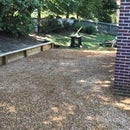Introduction: Workbench for Less Than $50.00
I felt that it was a right of passage as a woodworker to build your own workbench. I wanted a nice work surface but was not prepared to spend a fortune on something like maple for the top. The specialty lumber store in my area gave me a quote that I just couldn't afford. I had seen an article in popular mechanics about using LVL framing joist for the top and decided to give it a try. I modified from their design and incorporated a few others that I felt would suit me better. This instructable is my journey through the build and the ideas, problems, etc. that I discovered along the way. This is also a repurposing, recycling, reusing, "green" project as it uses leftovers that would be thrown away or destroyed.
Here is the link to the article that first gave me the LVL for the top idea. https://www.popularmechanics.com/home/interior-pr...
Step 1: Tools and Materials
Tools used:
- Table saw (for ripping LVL to size), which was a portable Dewalt table saw
- Circular saw (for shaping ends and other cuts)
- Drill (for adding bolts)
- 36" Clamps (for top and base glue up)
- Hammer (for bolts or other things that might need hammering)
Materials:
- LVL framing joist, I was able to use cut off scraps from the local lumber yard
- 4" bolts, nuts, and washers for base
- Glue
Step 2: LVL for the Top
LVL (Laminated veneer lumber Wikipedia) is basically big thick pieces of plywood. I was able to buy enough cut offs at the local building materials store. They were dirty and forgotten in the lumber yard. I spent less than $25 on this. In the article I referenced, they bought a whole piece of LVL and then had it cut. I believe this option would be closer to the $50 for just the lumber cost but that is just the cost at my local store. These will be ripped into 3" strips (or as thick as you want your top).
The boards are 1 3/4" x 9 1/2" x 5 1/2'. I planned for the top to be 5' across so I was able to trim the ends after ripping the strips. I got 3 strips from each board.
I wanted a width of 28" for the top, so I needed 16 strips.
Step 3: Ripping the LVL and Aligning for Glueing
Using my table saw, (if you don't own a table saw, you could use a circular saw with a guide or rent a table saw) I cut the boards into 3" sections. This is pretty straight forward. Making clean cuts during this stage will mean less work finishing the top after glueing.
Step 4: Glueing
This is where you can get overwhelmed. Woodworkers online, with more established working spaces, really take this part serious. They use a ton of clamps and glue in a precise manner. I did not have the luxury of using more clamps and I just glued as well as I could. I made sure that I had good contact between the boards and rolled the glue on with a paint roller. I did not do anything to the boards except lightly sand the sides that would receive the glue just to clean them up a bit. I then left the glue to dry overnight.
Step 5: Legs and Base
I wanted to try and create mortise and tenon (Wikipedia) legs that fit into the base and top. This was tricky for me.
I started by creating the feet. I needed one for each side. Using the LVL strips, I measured and cut out part of two strips in order to put them together and have a foot with a mortise. I cut out a curved section for the bottom, creating two points of floor contact for each side. For the tops, I cut out sections for the mortise, but no curve. It would be one long connection to the top. Each bottom and each top piece are two of the strips glued together. This method was an easier way for me to create the mortises.
As you can see, this wasn't the best looking work. They work, but needed to be cleaned up.
After cutting the leg pieces to size, I shaped the bottoms to create the tenons to fit into the mortises.
Step 6: Putting the Base Together
After fitting the base pieces together I decided to use bolts on either side of the mortises just to add some stability and a couple of the tenons did not fit as snuggly as I would like. This was accomplished by pre drilling holes for the bolts, hammering them in, and tightening the nuts. I used lock nuts to keep them from potentially coming undone.
Step 7: Add the Top and Its a Workbench
Once the base has been completed, place the top, well, on top. I cleaned up the edges with a couple passes on the circular saw. I did not attach the top to the base with fasteners, the top is heavy enough to withstand the forces I apply to it, which is just a home for my miter saw. If you plan to use this type bench for something with more directional forces, you should fasten the top to the base. This could be accomplished a few different ways (brackets, tenons, dowels, etc.) Top surface can be planed down or drilled into for bench dogs. I left this step off of my build as that was not what I was looking for with this build.
This was a simple build, it just took a lot of time to get everything situated. I was able to all of the work with a table saw, drill, and circular saw. If you were motivated enough, it could be completed without the table saw. If I were to do this again, I would have spent more time and resources on glueing the top pieces together. It could have benefited from a different method of securing, perhaps dowels or some other jointing techniques.

Participated in the
Build a Tool Contest













